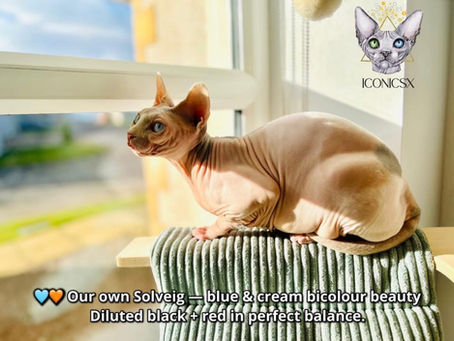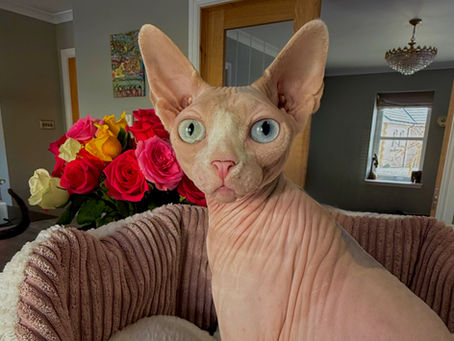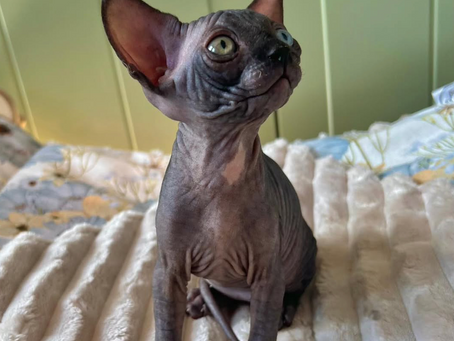top of page


Designer Cats - Have you ever wondered why some cats are labeled as “designer” ?
People love using labels to describe and mark things, events or even each other. It’s easier to stick a tag on something than to understand it. The same thing happens with genes. If a gene creates an unusual look, then it gets labeled as “designer”, which by the way, is still a very elegant way of naming things. This is nothing new in the breeding world, it was always like that. Let's start with a little history lesson and go back to the 1920s. The chocolate and lilac genes.
Iconicsx
Nov 116 min read


When “Cute” Turns Into Chaos: The Truth Behind Mixed Litters
You scroll past another video. Two queens maybe three nursing together. The comments never change — hearts, smiles, so beautiful, such love. In feral colonies this happens when it has to. A mother dies, one rejects her babies, another can’t make enough milk. The food is often scared and limited . that’s when they mix litters together. It’s instinct and survival. But in a proper breeding program it shouldn’t happen unless something breaks — illness, milk loss, complete reject
Iconicsx
Nov 23 min read


GENES DON’T LIE — Why Almost Every tortie Cat Is a Girl (and Why Male Torties Are So Rare)
You’ve seen them — those striking, fiery-coloured cats with a patchwork of black, red, sometimes softened with cream or kissed with a splash of white. They’re called torties, short for tortoiseshell. Bold in colour, bold in personality. But here’s the thing: Almost all torties are female. No, it’s not magic. It’s genetics. What makes a tortie? A tortie is a cat that shows two pigment colours: • Black-based (eumelanin) • Red-based (pheomelanin) To display both, the cat must
Iconicsx
Oct 202 min read


GENES DON’T LIE - Dilution Gene — When Colours Go Soft
Not every pastel is what it seems. And not every blue is actually… blue. There’s a little gene (we call it dilution - “d”) that changes the way colour shows up in a cat’s coat — or skin, if you live with a Sphynx. It doesn’t wipe out the pigment; it just spreads it differently. Think of it like mixing paint with water. The colour’s still there, just softer. But here’s the catch: That only happens if the cat gets two copies of the gene (d/d) — one from each parent. Just one?
Iconicsx
Oct 202 min read


GENES DON’T LIE - White Spotted Gene — How Much White Is Too Much White?
You’ve probably seen them — those dreamy white-and-colour cats with just a splash of black on the head, or a tail like it was dipped in paint. They’re called van or harlequin, and their colouring comes from a gene called white spotting — or ws for short. But here’s the twist: Not every cat with this gene looks the same. Some have just cute little socks or a white belly…Others are almost completely white — and yet they don’t carry the gene for dominant white (w) at all. So wha
Iconicsx
Oct 203 min read


GENES DON’T LIE — White Isn’t Just a Colour.
Imagine this: You’ve got a full painting underneath — rich colours, perfect patterns, a story written in genes. Black, blue, tortie…maybe even a classic tabby. But then? Someone pulls a pure white curtain over the whole canvas. And just like that — poof. It’s all gone. That’s what the white gene (symbol: W) does. It’s not really a colour gene in the traditional sense. It’s more like a genetic blackout. Let’s talk about it. What does it do? Just one copy (w/W) is enough to tur
Iconicsx
Oct 202 min read


GENES DON’T LIE : Dominant or Recessive Genes? It Makes All the Difference.
Every cat is a walking story. But that story doesn’t begin with their first breath, or with the first cry in the nest box. It begins earlier — quietly — in the places we can’t see. In the double helix. In the script written long before we even knew their name. Each kitten carries two copies of every gene. One from the mother, one from the father. Sometimes, those genes agree. And sometimes… they don’t. When that happens, one must speak louder. That’s when we meet two fundame
Iconicsx
Oct 202 min read


GENES DON’T LIE : Phenotype vs Genotype - What You See vs What They Really Carry
Every cat has two stories, although most people only notice one of them. The first story is simple because it is written on the surface: the colour of the coat, the shade of the eyes, the length of the body or the shape of the head, the kind of things you notice immediately when you look at a photograph. The second story is harder to read because it is hidden in the genetic code, and even when it does not show on the cat itself it can still be passed on to the kittens, often
Iconicsx
Oct 202 min read


GENES DON’T LIE - Chimera Cat
Chimera cats. People throw that word around too much. Have you seen a cat with a split face and odd eyes advertised as „Chimera”? Most of the time, it’s not. A chimera cat isn’t about looks – it’s about DNA. This phenomenon occurs when, at a very early stage of embryo development, two separate embryos fuse together to become one body. As a result, a cat is made up of two different genetic sets. It depends on what fused: XX/XX – Two female embryos → Female cat, quite often
Iconicsx
Oct 202 min read


The DBE Celestial Line — From First Litter to Champions
On 20th September 2025, just four months after first stepping into the show halls, both IconicSX Selina Kyle and Vincent became Champions under The Governing Council of the Cat Fancy (GCCF) — the UK’s most rigorous and internationally respected registry for pedigree cats. Each of their qualifying certificates was awarded by a different GCCF judge, with assessments carried out independently and in line with strict breed-specific standards. Iconicsx Selina Kyle is the 1st GCCF
Iconicsx
Sep 253 min read


When Policy Meets Science: GCCF New Rules for DBE Breeders
How the 2025 Update Impacts DBE Breeders in the UK This week, the GCCF introduced formal registration guidelines for cats carrying Dominant Blue Eye (DBE) variants. There was also a small update — a paragraph in a policy document — but for those of us working transparently with these lines, it meant everything. “The registration policy for the breed does not exclude DBE cats from GCCF registration.” — GCCF Registration Policy, 2025 update For the first time, structure replace
Iconicsx
May 216 min read


THE CONSCIOUS KITTEN: GROWING RESILIENCE Part 4 — True Kitten Socialisation: What It Is — and What It Is Not
These days, too many people confuse activity for confidence. They see compliance and call it trust. But a kitten that runs up to every person isn’t always brave. And a kitten that stays still when squeezed isn’t always relaxed. Iconicsx Bruce and Iconicsx Selina True socialisation isn’t how fast they approach strangers. Or how long they let themselves be held. It’s not about performance. It’s about emotional regulation. And regulation takes time. It needs rhythm. It needs res
Iconicsx
May 203 min read


The Conscious Kitten: Growing Resilience Part 3 – Kitten Emotional Regulation
Let's tlak about Kitten Emotional Regulation. From the start, kittens rely on rhythm. Touch, nursing, sleeping, waking, little adventures… then back to safety. Again and again. It's not random. It ’s biology doing what biology does best — build from repetition. Iconicsx Selina Kyle - DBE CEL Odd Eyed Kitten This rhythm — it’s more than just comforting. It teaches the body how to shift gears. It gives the brain signals: now it’s time to go, now it’s time to rest. It builds
Iconicsx
May 203 min read


The Conscious Kitten: Growing Resilience — Part 2: Immune Maturity in Kittens
A kitten doesn’t come into the world with a ready immune system — it builds one, piece by piece, starting with something as tiny as bacteria. When a kitten is born, it’s a blank slate — sterile, untouched by the outside world. But almost immediately, something beautiful happens. As it nurses, is licked clean, and nestles up against its mother, she shares with it a whole invisible world of microbes. Researchers like Chan et al. (2013) and Zakošek Pipan et al. (2020) have descr
Iconicsx
May 113 min read


The Conscious Kitten: Neurological Maturity: Part 1 The Unfinished Architecture.
People often like to say, ‘Wow, kittens are so fearless! They watch them darting across the room, leaping on siblings, swatting at a flicker of light on the wall, and they figure — this kitten’s ready for anything. But here’s the truth: what you see on the outside doesn’t tell the whole story. Underneath that playful energy, there’s a brain that’s still working hard to finish wiring itself. It’s busy building the roads, the bridges, the connections that will shape how the ki
Iconicsx
May 114 min read


IconicSX is now TICA Outstanding Cattery Certificated ! Setting the standards for Ethical Sphynx Breeding.
We are beyond excited to share some incredible news with all of you! IconicSX Cattery has officially been awarded the prestigious TICA Outstanding Cattery Certificate , a recognition that highlights our dedication to providing a safe, clean, and well-maintained environment for our cats. A Milestone Achievement On 9th January , our cattery underwent a comprehensive inspection by a licensed veterinarian as part of the TICA Outstanding Cattery Program. This process involved an
Iconicsx
Jan 162 min read


✨ First DBE Celestial in Sphynx Breed Confirmed ✨
We are proud to announce that IconicSX Cattery is home to the first Sphynx cat with a genetically confirmed DBE Celestial gene. O ur Queen Sofia is genetically confirmed heterozygous N/ DBECEL, one of the safest Dominant Blue Eye (DBE) genes recognised today. This line is the best studied and well known for its genetic health*, making it a cornerstone of our breeding program. The DBE-CEL gene , previously classified under the DBE-Altai group, was officially identified and d
Iconicsx
Jan 63 min read


🌟 IconicSX is Officially GCCF Approved Sphynx Cat Breeder 🌟
We are beyond thrilled to announce that IconicSX is now officially part of the GCCF Breeder Scheme as GCCF Approved Sphynx Cat Breeder . IconicSX was founded exactly in 2023 , and we welcomed our very first litter in June 2024 . As such a young cattery, achieving this prestigious recognition is an incredible milestone, and we couldn’t be more proud. We applied for the Approved Breeder Scheme at the beginning of September 2024 , and on 26 November , our assessment took pl
Iconicsx
Dec 9, 20242 min read


HCM in Sphynx Cats : A Closer Look at the Recent ALMS1 and HCM Study: Are We Missing the Full Picture?
There has been growing discussion among breeders about the ALMS1 gene and its connection to hypertrophic cardiomyopathy (HCM) in Sphynx cats. However, some misunderstandings have arisen, particularly in interpreting the clinical data from a recent study. The study focused on a relatively small sample of 55 Sphynx cats. While the data offers valuable insights, it’s important to note that conclusions drawn from such a limited sample should be viewed cautiously. Additionally, si
Iconicsx
Oct 31, 20245 min read


Gene Testing in Sphynx Cats : Why Extensive Gene Testing Is a Responsible Choice—Even If some genes are Not Yet Linked to the Sphynx Breed.
Recently, I learned that some discussions in a local Facebook group involved mockery of my choice to test my cats for a wide range of genetic markers—beyond those typically associated with the Sphynx breed. It’s ironic, really, how some people seem more focused on exposing their own ignorance than on improving their breeding practices. So, let me set the record straight and focus on what really matters: the health and future of the breed. Exposing Ignorance Let’s start with t
Iconicsx
Oct 31, 20242 min read
bottom of page


